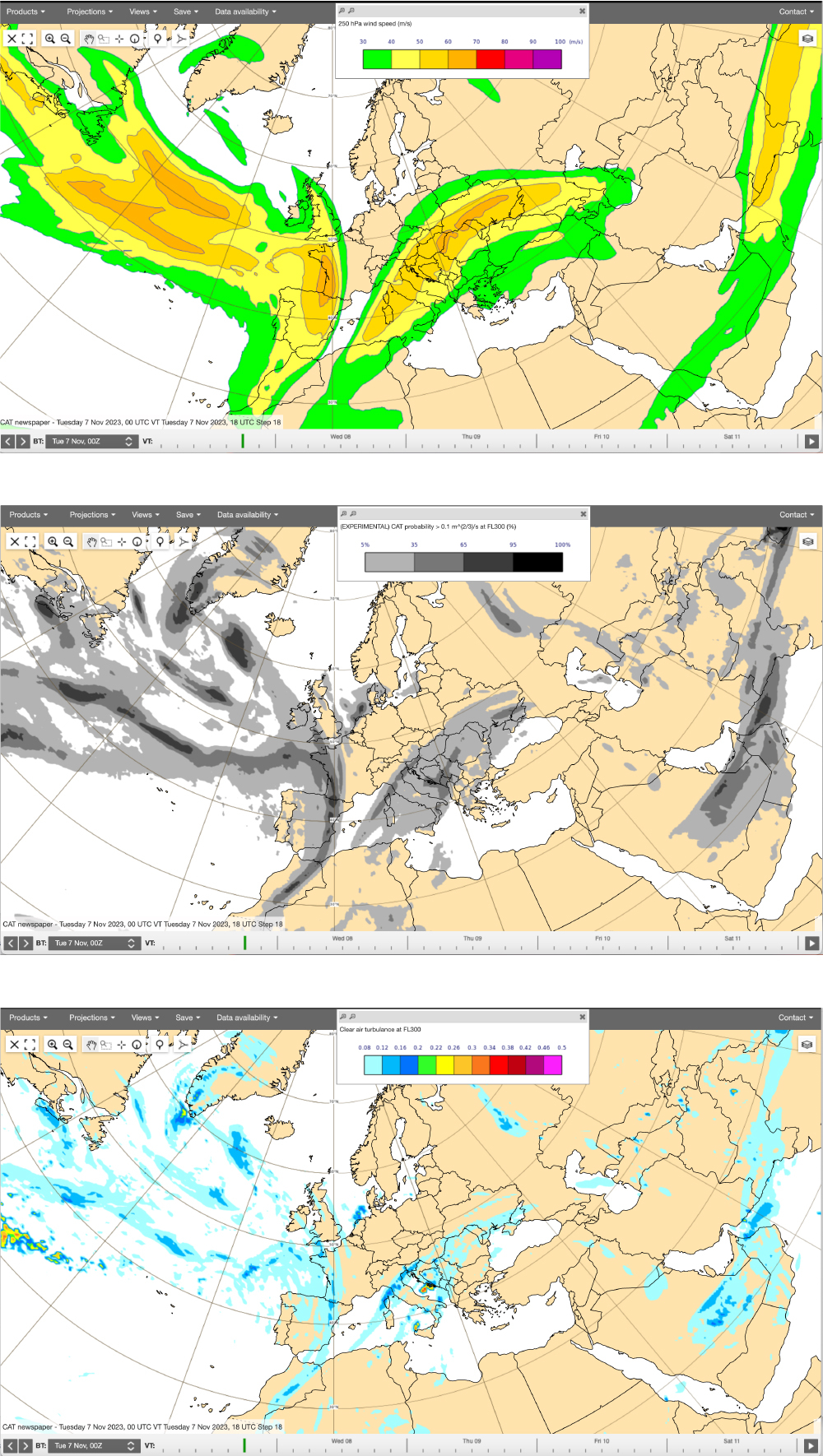Clear-air turbulence (CAT) is the main weather threat to civil aviation at cruising level in the lower stratosphere. It is generated from shear instabilities near jet streams and boundary-layer inversions, thermal instabilities, and breaking small-scale gravity waves. The latter phenomenon is generated predominantly above orography and convective clouds. As requested by users, a CAT parameter has been developed together with the Deutsches Zentrum für Luft und Raumfahrt (DLR) in Germany, and it has now become a fully probabilistic product.
CAT was originally made available from ECMWF’s high-resolution forecast in October 2021, with the introduction of Cycle 47r3 of the Integrated Forecasting System (IFS). It is based on the Eddy Dissipation Rate (EDR) (m2/3s–1), which is the international standard measure of turbulence in aviation (see ECMWF Newsletter No. 168). CAT has been provided on specific flight levels in ecCharts since then, as requested by our Member States, and specific EDR thresholds are generally used to distinguish between light, medium and severe turbulence.
Probabilistic CAT
Free atmospheric turbulence is an intermittent and rare process: it occurs only 1–3% of the time as derived from research aircraft measurements. A probabilistic approach can help to judge the significance and to obtain reasonably smooth fields. With the introduction of IFS Cycle 48r1 and the availability of a high-resolution (9 km) 51‑member ensemble since June 2023, we have extended the graphical processing of CAT to turn it into a fully probabilistic product. This required, however, extensive optimisation of the post-processing suite that interpolates the CAT fields from model levels to height levels and then to flight levels. A set of probability thresholds (probability of CAT exceeding 0.1, 0.15, 0.25, 0.32, 0.45 m2/3s–1) is then computed for each flight level. We can now provide the highest resolution probabilistic CAT product worldwide in terms of vertical and horizontal resolutions and ensemble size. The illustration shows three aspects of an 18-hour forecast from 7 November 2023 at 00 UTC: the wind field at 250 hPa; the probability of CAT to exceed 0.1 m2/3s–1; and CAT from the high-resolution (HRES) suite, which has the same 9 km resolution as the ensemble forecast introduced in June 2023. Regions of light to moderate turbulence can be seen in the fringes of the jets over the central Atlantic, western Europe and northern Italy. There is also orographically enhanced turbulence over the Dalmatian islands, off Sicily, and off the southern tip of Greenland.
Both CAT and high-resolution probabilistic CAT products are accessible in ecCharts. Editing these layers will let users choose the flight level and, in the case of the probabilistic CAT layer, the probability threshold to be visualised.

Other products
Active users of ECMWF’s CAT forecasts include the Hungarian Meteorological Service (OMSZ) and the Croatian Meteorological and Hydrological Service (DHMZ), from whom we receive valuable feedback for improvement. Other available CAT products worldwide include the Graphical Turbulence Guidance (GTG), which was developed at the US National Center for Atmospheric Research (NCAR). This is used by the US National Oceanic and Atmospheric Administration (NOAA) weather service and also by the UK Met Office and the Korean Meteorological Administration. Contrary to the ECMWF product, where CAT is computed online during the forecast, the GTG is a post-processing package that computes a large set of turbulence-related parameters and provides adapted graphical output. A similar procedure to the one used for the GTG has also been adopted by Météo-France, although its CAT product also includes the turbulent kinetic energy as a parameter. Finally, the CAT provided by the German Meteorological Service (Deutscher Wetterdienst) is based on summing over all sources of turbulent kinetic energy as available from the ICON model. It is therefore the most similar quantity to the ECMWF CAT, which is based on a method including available physical sources of turbulent dissipation.
Monitoring and climatology
Compared to other available and mature aviation products as mentioned above, the ECMWF ensemble CAT provides complementary guidance as it is close to turbulent dissipation in the IFS model. The introduction of stochastic parameter perturbations in the upcoming IFS Cycle 49r1 will further improve the sampling. However, the product could benefit from further calibration, and we aim to further evaluate CAT with available observations. Unfortunately, aircraft observations of EDR are difficult to obtain and remain the property of the individual airlines. We therefore plan, in collaboration with colleagues from Yonsei University (Seoul, South Korea), to pursue the validation by deriving EDR values from high-resolution radiosonde data using the well-known Thorpe method in turbulence.
A climatology of post-processed CAT has recently been established by a group at Seoul National University for ECMWF’s ERA5 reanalysis, using the GTG software. The new ECMWF CAT will be available in ECMWF’s upcoming ERA6 reanalysis on pressure levels. This will facilitate a new climatology of CAT and make it easier to monitor its evolution in a changing climate.

